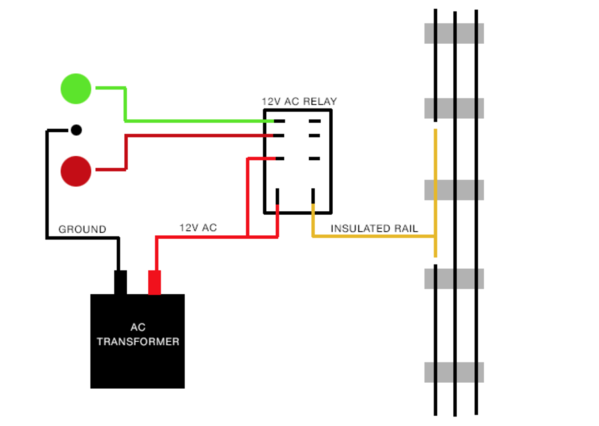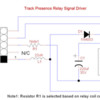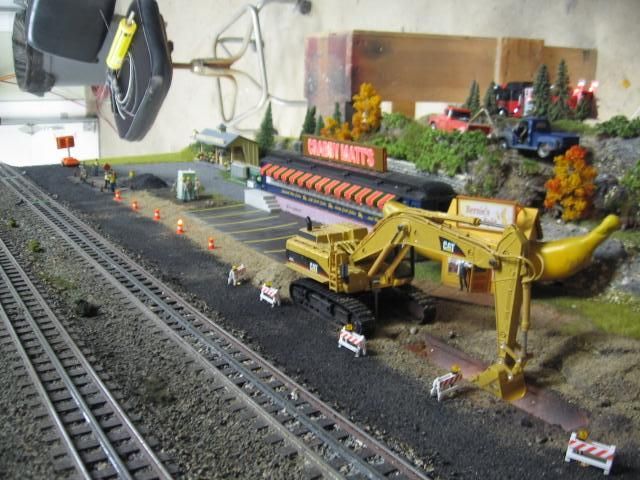On the schematic above that GRJ posted, the relay marked as 12V coil was looks like it's being powered from the terminal marked 'center track' using a choke (for DCS) and diode and an isolated rail for common. I was just wondering if the one diode was enough to reduce command voltage to something useable by the 12V relay? The terminal marked 'Center Track' was what got me wondering?
I have AD/DC converters and even some DC power supplies, but I am not certain how much voltage a bridge rectifier or diode drop the voltage...like the half wave/full wave, RMS and all that stuff? That is what I was wondering about.
Ok... this has a number of answers, depending what parts you're using.
1. Using only a single diode will effectively cut AC RMS voltage in half as it kills the half of the AC wave negative to its polarity. However the voltage will turn on and off at 60 cycles, it's still AC. For something like a light bulb this will work out ok, but might cause a chatter in a relay. I'm not really sure on that. It is pretty much useless for any sort of solid state device.
2. A single diode with a capacitor across the ground and diode's 'output'. With the cap added, it stores energy so that as long as the load is not enough to drain the Cap before the next cycle it will hold the voltage at a constant level. This voltage is a bit hard to figure the math on, and I couldn't locate a formula on it as most folks tend to use a bridge rectifier and/or use the single diode and cap(half wave rectifier). It works similar to a bridge rectifier (see below), but because the input voltage peaks half as often and the capacitor must hold the voltage over the 'negitive' half of the wave, the effective voltage is slightly lower than the 1.4141 multiplier used on a bridge rectifier.
3. Diode bridge: using 4 diodes set up in the format of a bridge allows the current to pass through from both sides of the AC wave, allowing the full energy of the AC to move to the +/- leads. It is still an oscillating wave, but rather than moving in the familiar sine pattern it is converted to a series of positive bumps, each starting at the end of the last. In the end this behaves similar to using a single diode, and I can't recall ever seeing a non rectified diode bridge.
4. The bridge rectifier: by combining the bridge with a capacitor to hold the energy of the oscillating current the bridge rectifier supplies the full energy of the incoming AC current, again, so long as the cap is large enough to power the load. When you convert AC to DC the DC voltage is approximately 1.4141 times higher than the AC voltage. This is because of the way AC voltage is measured for it's ability to power things. You've probably seen the term RMS on meters and such. This is Root Mean Square and what it means is that you take a number of measurements of the voltage throughout the arc of the rising and falling sine wave, the more measurements the better. Each value is squared (multiplied by it's self), then the total of all reading on that wave are added together. The value is averaged by dividing by the number of readings taken (mean). The square root of that average value is then taken as the value, or ac voltage, and fairly effectively shows the useful energy in the AC power. The capacitor in the bridge rectifier, however, holds the peak voltage of the wave, which works out to being about 1.4141 times higher than the RMS voltage of a 60 cycle sine wave.
So with a full wave bridge rectifier (4 diodes and a capacitor) the DC voltage is substantially higher than the AC input voltage. this is why you see volks suggesting using at least 35V rated caps and such in the circuits even though track power is 18VAC( 35v is often the first standard value higher than 25v). That 18 VAC when rectified produces over 24VDC.
As one last bit to mess with the math, a typical silicon diode will drop about 0.6 volts off the current passing through it. this is a good way to drop voltage as opposed to using a resistor because diodes are a whole lot less expensive for the current they can handle. for example, to cut the brightness of a little 5 watt light bulb in half you would also need a 5 watt resistor. not the cheapest or easiest thing to come by. On the other hand a string of 1n4001 diodes cost around a penny each, and can handle the same current as an 18 watt resistor at 18V.
I think I just came up with an idea for my first video on electronics...
JGL










